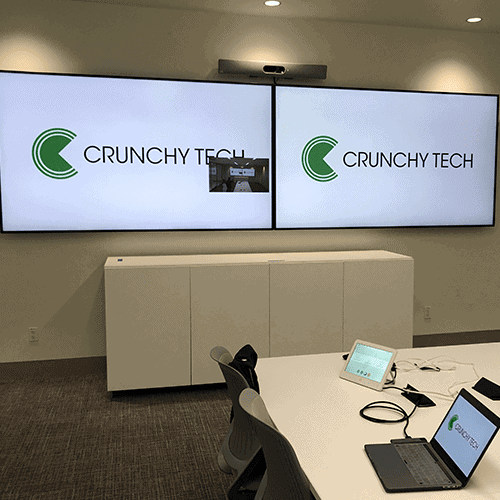Which is Better for Your Business—AV over IP or Traditional Matrix Switching?
If you are wondering what AV system is fit for your business, we can help you. Today, businesses are using AV over IP to improve their audiovisual systems by sending audio and video signals over standard IP networks. When compared to traditional matrix systems, this solution is flexible and scalable. Businesses can easily share content across several displays, such as video walls, with networked AV setups with no complicated cabling. IP based systems mean that companies can take advantage of standard LAN infrastructures for AV setups, and grow them easily.
A standout feature of AV over IP is using HDMI over IP matrix technology as one of its features, which allows for the effortless distribution of high quality video, up to 4K resolutions. The system is highly scalable and adaptable because this technology works together with IP switches and standard network equipment. Further, IR control signals can be sent over the network, enabling remote control of AV devices and making AV professionals’ job easier. As such, AV over IP is an ideal choice for businesses wanting to modernize and future proof their AV environments.
What is AV Over IP?
AV over IP refers to the transmission of AV signals over an Internet Protocol (IP) network, rather than through traditional analog methods or dedicated AV cabling. This technology converts AV signals into digital packets, which can then be sent over standard Ethernet networks. As a result, businesses can leverage their existing network infrastructure to manage AV content efficiently.
Using AV over IP technology, companies can integrate multiple sources seamlessly. For instance, a restaurant can broadcast different sports events simultaneously on various screens using a single network. This capability not only simplifies setup but also reduces costs associated with dedicated cabling and hardware.

How Does an AV-Over-IP Solution Work?
An AV over IP solution usually consists of encoders, decoders, transmitters and receivers. Audio and video signals are converted to a digital format amenable to IP transmission through encoders. Then standard protocols are used to transmit these signals over the network.
When they get a destination, decoders interpret the digital packets back to display or play on whatever the intended devices are. There are transmitter and receiver pairs that ensure signals are transmitted and received without the loss of quality.
Here’s a simple illustration of how the process works:
| Component | Function |
| Encoder | Converts audio and video signals into digital packets. |
| Transmitter | Sends digital packets over the IP network. |
| Receiver | Receives digital packets and converts them back to audio and video signals. |
| Decoder | Final step in converting digital packets for output. |
Why Choose AV Over IP Over Traditional AV?
There are many advantages when shifting from traditional AV systems to AV over IP. Typically, traditional systems depend on particular cabling or hardware logistics that are expensive and inflexible. On the other hand, AV over IP uses regular network equipment, making it easy to expand or alter business setups.
AV over IP has one key advantage over AV: Scalability.
New sources and displays can be easily added to companies’ networks without rewiring. Such flexibility is just what is needed for an environment such as a sports bar where multiple events could be displayed at once.

What Are the Key Components of AV Over IP?
An AV over IP includes encoders, decoders, network switches and control interfaces..
- Encoders and decoders: As I mentioned above, these are devices that are important to convert audio and video signals into IP packets and back. High quality transmission of video and audio is ensured; they can support 4K and 1080p resolution.
- Network switches: High performance AV over IP requires a gigabit Ethernet network. These switches control the traffic and prevent audio and video content delivery from having any latency.
- Control interfaces: Users can easily select inputs, change volume levels, and switch between sources with the help of the control system for the AV network to manage efficiently.

What Are the Challenges of Implementing AV Over IP?
However, there are drawbacks to changing to AV over IP, too. Network latency is one concern, resulting in effect on audio and video playback quality. Businesses need to make sure their networks can cope with higher traffic that AV content generates.
The other challenge is the need for technical expertise.AV over IP is fairly new technology, and setting up and maintaining it requires a basic knowledge of networking and AV technologies.ency, which can affect the quality of audio and video playback. Businesses must ensure that their networks can handle the increased traffic generated by AV content.
Another challenge is the need for technical expertise. Setting up and managing an AV over IP requires a certain level of knowledge regarding networking and AV technologies. Management of the system may require companies to invest in training, or even hiring people with special skills.
How to Choose the Best AV Over IP Products?
When selecting AV over IP products, consider the following factors:
- Resolution Support: Make sure the network can handle the resolution you want, whether that’s 1080p or 4K.
- Network Compatibility: Pick products that work in your existing network infrastructure to avoid adding costs.
- Scalability Options: Seek solutions that give you the ability to expand easily as your business grows.
In the AV over IP market some reputable brands are Crestron, QSC, and Extron that provide a wide option cater to different needs.
Where Are AV Over IP Best Utilized?
AV over IP is ideal for various settings, including:
- Sports Bars: Demand for displaying multiple games and events simultaneously at the same time.
- Corporate Environments: Great for presentations and meetings where you need to show different content.
- Educational Institutions: It enables broadcasting lectures and presentations in multiple classrooms.
How Does AV Over IP Handle Scalability?
With unparalleled scalability, AV over IP systems are a must have for today’s corporate environment. This scalability is mostly realized as a result of a modular design, which allows easy expansion by just plugging additional encoders and decoders onto the existing network infrastructure. AV over IP is different from traditional AV setups that require a lot of rewiring for growth and instead uses standard network equipment, allowing organizations to use their existing IP network for AV distribution. This makes expansion easier, but also offers a more economical way of scaling AV capabilities.
In addition to scalability, AV over IP can extend to future proofing. These systems can be designed to adapt to higher resolutions, new compression algorithms, or new AV formats as technology changes — some via software updates and others through the introduction of very minimal hardware change. Because of that flexibility, businesses can keep up with the latest technological trends without having to restart their entire AV infrastructure. But when AV over IP systems are scaled, IT professionals must think about things like network capacity, latency management and security measures to get the best possible performance and protection as the system grows.
AV over IP is changing the way businesses manage their audiovisual environment
AV over IP is changing the way businesses manage their audiovisual environment, providing flexible, scalable, and seamless integration with existing LAN infrastructures. Distributing high quality video across video walls and multiple displays has never been easier with HDMI over IP matrix technology. If you’re wanting to improve upon your existing setup or searching for a more efficient way to manage audiovisual systems, then networked AV is the solution for you.
If you’re ready to change the way you do AV, Crunchy Tech is here to help. We are a team of AV over IP experts that specialize in solutions tailored to your business needs. If you want to learn how we can help create a future proof AV system that delivers superior performance and flexibility, contact us today. Together, let’s push your AV systems to the next level!